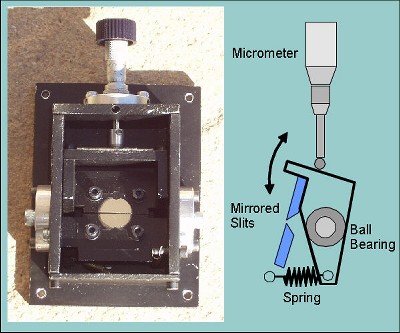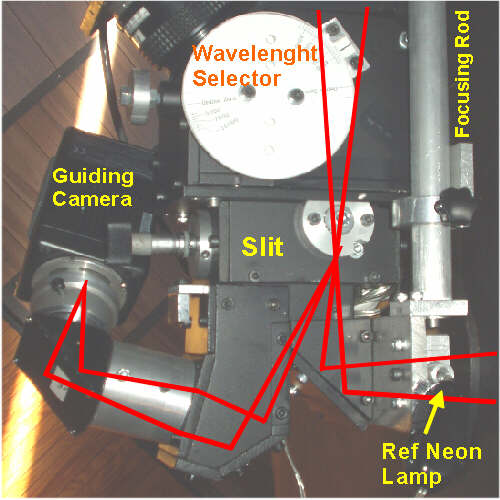SPECTROGRAPHS AND RELATED INSTRUMENTS
Spectrographs -
Entrance Optics
- CCD
- Atmosphere
- Flessioni meccaniche
Entrance Optics with reflective slit
The main problem that I encountered in using my spectrograph is the loss of signal because not all the light from a star can enter a narrow slit due to defects of focus, guiding and bad seeing.
This problem is less evident with small telescopes because the size of a 2 arc-sec star image is usually much smaller than the slit. As an example, for a telescope with a 1 meter focal lenght the blur size of a 2" star is 10 mm while a common slit is 50 or 100 mm.
But when using bigger telescopes the linear size of the star increases and become comparable to the size of the entrance slit. Bad guidance, focusing and seeing then can easily move the star out of the slit with dramatic loss of signal.
I have the opportunity to use, time to time, the 60 cm telescope of Campo dei Fiori Observatory (MPC 204), near Varese (Italy).
At the Cassegrain F/20 focus I've installed a spectrograph with 300 mm collimator spherical mirror, plane gratings (600 and 1800 l/mm) and a 50 mm focal lenght camera lens. CCD pixel size is 9.8 mm. One CCD pixel is thus equivalent to a 9.8x300/50 =60 mm wide slit on the focal plane.

|
|
Picture 1: Image and layout of the mirror slit realized with two razor blades mirror polished.
|
But the size of a 2 arcsec star image at the focus of this telescope is 120 mm (12 meters focal lenght !!) and thus I have to use at least a 120 mm wide slit, that is 2 pixel large on the detector.
Even with such a large slit, there is the possibility of loss of light if the guidance accuracy is not within one arc sec and any slight misalignment of the guiding refractor with the main telescope will results in dramatic loss of signal.
A way to improve the spectrograph is to increase the collimator focal length perhaps to 40 or 50 cm. In this case one CCD pixel will become 80 or 100 mm on the focal plane, at the expense of an increase of the beam size, grating size, and camera lens diameter. The same effect is produced by a focal reducer.
An other way to increase the amount of light entering the slit is to improve the guidance of the star using a reflecting slit and thus guiding directly on the image of the star reflected by the slit lips.

|
|
Picture 2: The entrance optics with the optical path of the beam that is reflected from the mirrored slit. The spectrograph will be mounted on a sliding device to assure an easy focousing (independent from the secondary mirror that is not motorized)
|
I've thus re-designed the entrance optics and mechanics of my spectrograph (I'm a lucky man because I've a lathe at home). The slit is composed of two inox razor blades that I've polished with carborundum and Cerium Oxide. The image reflected by the slit limbs is collected by a 80 mm lens and re-imaged with a magnification ratio 1:1 on a 40 mm eyepiece (300 X).
Even if I've not yet installed the old spectrograph on the new entrance optics, I've tested the new guidance system and it seems to work properly. I see the dark narrow slit that crosses the star image as it is shown in the pictures below. This ensures me that light from the star is effectively entering the spectrograph.
At the beginning of March 2004 I've installed the spectrograph onto the new entrance optics, adding a B/W camera for guiding the star that is reflected by the mirrored slit blades. A detailed view of the spectrograph is shown in picture 3.

|
|
Picture 3: The spectrograph at the Cassegrain focus of the 0.60 m reflector of Campo dei fiori Observatory (Varese) with the new entrance optics and TV Camera for guiding.
|
|
|



